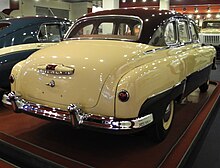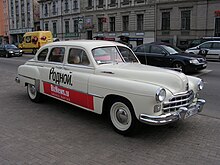GAZ-12 ZIM
| GAZ | |
|---|---|
|
GAZ-12 ZIM in a museum in Riga (2011)
|
|
| GAZ-12 ZIM | |
| Sales designation: | ГАЗ-12 ЗИМ |
| Production period: | 1950-1960 |
| Class : | Upper class |
| Body versions : | limousine |
| Engines: |
Otto engines : 3.5 liters (70 kW) |
| Length: | 5530 mm |
| Width: | 1900 mm |
| Height: | 1660 mm |
| Wheelbase : | 3200 mm |
| Empty weight : | 1800 kg |
| successor | GAZ-13 Chaika |

The GAZ-12 ZIM ( Russian ГАЗ-12 ЗИМ ) is a luxurious and representative Limousine the upper class , of the Soviet GAZ was prepared -Werken 1950-1960. The abbreviation ZIM stands for S awod I meni M olotowa, which should reflect part of the name of the factory at that time ( Molotow -Werk ) within the model name . A total of 21,527 examples of this large car, which was reserved for the official authorities of the Soviet Union, were produced in three versions. From 1959 the successor was the much more modern GAZ-13 Chaika .
history
Immediately after 1945 brought the state automobile - and commercial vehicle manufacturer GAZ (Russian Горьковский автомобильный завод (ГАЗ) dt. Transcription GAZ translated Gorkier car plant ), the honor of Vyacheslav Molotov officially addition of 1932-1956 still Zavod Imeni Molotowa ( SIM ) was the name of some new motor vehicles under the direction of Andrei Lipgart and Nikolai Juschmanow .
The GAZ-M20 Pobeda mid -range car presented in 1946 was followed by the large and luxurious GAZ-12 ZIM in 1950 , because the leadership of the party and the state now wanted a new large and representative car. The self-supporting body of the GAZ-12 was essentially derived from the GAZ-M20 Pobeda; it was based on a correspondingly longer, wider and reinforced floor assembly. The long-stroke six - cylinder in - line engine had an aluminum cylinder head and upright valves (which were already obsolete at the time) from the GAZ truck range . He gave his performance a hydraulic and a dry clutch, a mechanical three-speed synchromesh transmission with column shift , and a propeller shaft to the rear axle. It was rigid and suspended from leaf springs. The front wheels were individually attached to double wishbones . There were hydraulically operated drum brakes on all wheels.
The ZIM is stylistically and technically of a similar conception as contemporary US-American automobiles and had a similar, no less comfortable as well as extensive equipment similar to the models. The electrically heated rear seat bench and the automatically resetting turn signal lever on the steering column were a novelty . The dashboard painted in wood grain with a number of control instruments and a car radio were also part of the standard equipment. There were also leather seats and fine wood paneling. The sedans had three side windows and six seats, and a little later a four-door convertible was added, which was produced in very small numbers (probably only five copies) and which the factory called Phaeton . There was also an ambulance version , but with the limousine body, the interior of which was redesigned for the purpose - whereby the stretcher had to be loaded and unloaded via the trunk lid that was opened upwards. There was no station wagon version .
During the 1946 ZIS-110 , a replica of the US Packard 180 from the pre-war period, which was manufactured on the original Packard production facilities acquired by the Soviet Union, was reserved for the highest representatives of the state (including in a heavily armored version Josef Stalin himself ), the GAZ-12 ZIM was rather the car for the middle and upper cadre of the nomenklatura . The ZIM was exported only limited due to the high price, including some copies of Poland , in the Czechoslovakia and the German Democratic Republic , in Czechoslovakia, he should replace the Tatras before the war, but not yet found because of poorer performance and the first fully satisfactory workmanship no greater appeal. In 1955, the newly developed Tatra T 603 was introduced there instead . In the Soviet Union, on the other hand, the car was widespread and could still be used for many years even after production ended. It was also used by the militia , these vehicles being painted dark blue with red stripes on the sides and having a red flashing light on the roof. In 1960 production of all three versions of the GAZ-12 ZIM ended after a total of 21,527 units.
After being retired from civil service, a number of these cars, after being replaced by the more modern GAZ-13 Tschaika, which appeared in 1959 as a successor, came into private hands until the mid-1970s and have in some cases survived to this day. In the GDR, a larger number of vehicles were used as taxis after they were retired from civil service until the early 1970s.
Driving impression
The ZIM is a quiet and comfortable touring car. Its driving behavior is similar to that of comparable American automobiles of the time, which it also resembles outwardly. Due to the high weight (1940 kg with a full tank or over 2 t with driver) and the rather modest engine output of just over 90 hp (66 kW), the performance is leisurely, which together with the indirect steering, which is difficult to move at a standstill and at crawling speed is, any attempt at a sporty driving style thwarted from the start. The driving behavior is unproblematic and always in the neutral range. The available power is still acceptable today for smooth and comfortable locomotion, since the engine is elastic and therefore the gears do not have to be changed as often. The suspension comfort can convince despite the rigid rear axle on leaf springs .
Because of the hydraulic clutch, which creates a sliding frictional connection with increasing engine speed, the clutch only needs to be operated to engage a gear and to shift up and down; however, the vehicle can be braked from any speed to a standstill, for example in 3rd gear, and then started again without using the clutch. In conjunction with the smooth-running engine, this constructive solution achieves an impressively low interior noise level and excellent elasticity. One disadvantage is that the drive train cannot be mechanically blocked as a result. This means that you have to rely on the handbrake to work even on the steepest incline.
The processing quality of the ZIM fluctuated somewhat at the beginning, but at least for the models built from 1954 or 1955 it must be called decent.
Versions
- GAZ-12 ZIM sedan
- GAZ-12A ZIM taxi
- GAZ-12B ZIM ambulance
- GAZ-12 ZIM Phaeton (four-door convertible)
Export countries
- People's Republic of Poland
- Czechoslovakia
- GDR
- Finland (including as a large-capacity taxi)
Technical specifications
- Length: 5530 mm
- Width: 1900 mm
- Total height: 1660 mm
- Wheelbase: 3200 mm
- Ground clearance: 200 mm
- Engine: six-cylinder in - line engine , stationary valves , liquid cooling ( pump and thermostat )
- Displacement: 3485 cm³
- Bore × stroke: 82 mm × 110 mm
- Mixture preparation: a double downdraft carburetor K-21
- Compression: 6.7: 1
- Output: 95 PS (66 kW ) at 3600 rpm
- Clutch: hydraulic clutch and single-plate dry clutch
- Transmission: three-speed manual transmission , partly synchronized, 2nd and 3rd gear , selector lever on the steering wheel ( steering wheel gearshift )
- Drive type: rear-wheel drive
- Front axle: independent suspension on double wishbones , coil springs , double-acting hydraulic lever shock absorbers
- Rear axle: Rigid axle on semi-elliptical leaf springs , double-acting hydraulic lever shock absorbers
- Empty weight: 1800 kg
- Weight with a full tank: 1940 kg
- Permissible total weight: 2450 kg
- Brake system: drum brakes all around
- Turning circle: 14.8 m
- Top speed: approx. 130 km / h (half loaded: 125 km / h - fully loaded: 120 km / h)
- Standard consumption: 15.5 l / 100 km at 50–60 km / h
- Price (1954): 40,000 rubles
literature
- The new Soviet passenger car "SIM". In: Motor vehicle technology 2/1951, pp. 40–44.
Web links
- Picture of an originally preserved GAZ-12 ZIM
- Picture of a restored two-tone GAZ-12 ZIM ( Memento from March 12, 2007 in the Internet Archive )

